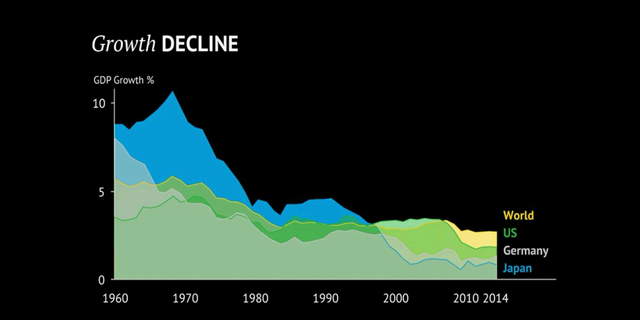
Growth is fading away, and it's a big deal. Our global economy stops growing. And it's not new. Growth has actually declined for the last 50 years. If we continue like this, we need to learn how to live in a world with no growth in the next decade. This is scary because when the economy doesn't grow, our children don't get better lives. What's even scarier is that when the pie does not grow, each of us get a smaller piece. We're then ready to fight for a bigger one. This creates tensions and serious conflicts. Growth matters a lot.
If we look at the history of growth, times of big growth have always been fueled by big manufacturing revolutions. It happened three times, every 50-60 years. The steam engine in the middle of the 19th century, the mass-production model in the beginning of the 20th century -- thanks, Mr. Ford. And the first automation wave in the 1970s.
Why did these manufacturing revolutions create huge growth in our economies? Because they have injected huge productivity improvement. It's rather simple: in order to grow, you need to be producing more, putting more into our economy. This means either more labor or more capital or more productivity.Each time, productivity has been the growth lever.
I'm here today to tell you that we are on the verge of another huge change, and that this change, surprisingly enough, is going to come from manufacturing, again. It will get us out of our growth slump and it will change radically the way globalization has been shaped over the last decade. I'm here to tell you about the amazing fourth manufacturing revolution that is currently underway.
It's not as if we've done nothing with manufacturing since the last revolution. Actually, we've made some pretty lame attempts to try to revitalize it. But none of them have been the big overhaul we really need to get us growing again. For example, we've tried to relocate our factories offshore in order to reduce cost and take advantage of cheap labor. Not only did this not inspire productivity, but it only saved money for a short period of time, because cheap labor didn't stay cheap for long. Then, we've tried to make our factories larger and we specialized them by product. The idea was that we can make a lot of one product and stockpile it to be sold with demand.
This did help productivity for a while. But it introduced a lot of rigidities in our supply chain. Let's take fashion retail. Traditional clothing companies have built offshore, global, rigid supply chains. When fast-fashion competitors like Zara started replenishing their stocks faster from two collections a year to one collection a month, none of them have been able to keep up with the pace. Most of them are in great difficulties today.
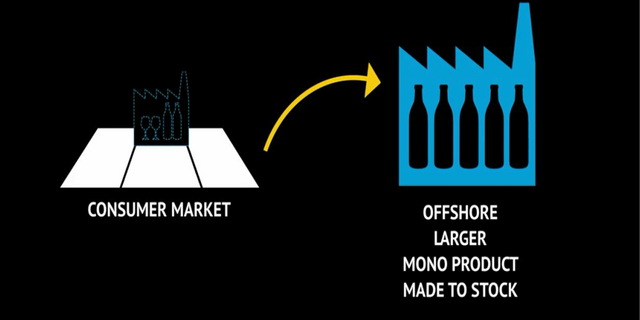
Yet, with all of their shortcomings, those are the factories we know today. When you open the doors, they look the same as they did 50 years ago. We've just changed the location, the size, the way they operate.Can you name anything else that looks the same as it did 50 years ago? It's crazy. We've made all the tweaks to the model that we could, and now we hit its limits.
After all of our attempts to fix the manufacturing model failed, we thought growth could come from elsewhere. We turned to the tech sector -- there's been quite a lot of innovations there. Just to name one: the Internet. We hoped it could produce growth. And indeed, it changed our lives. It made big waves in the media, the service, the entertainment spaces. But it hasn't done much for productivity. Actually, what's surprising is that productivity is on the decline despite all of those innovation efforts. Imagine that -- sitting at work, scrolling through Facebook, watching videos on YouTube has made us less productive.Weird.
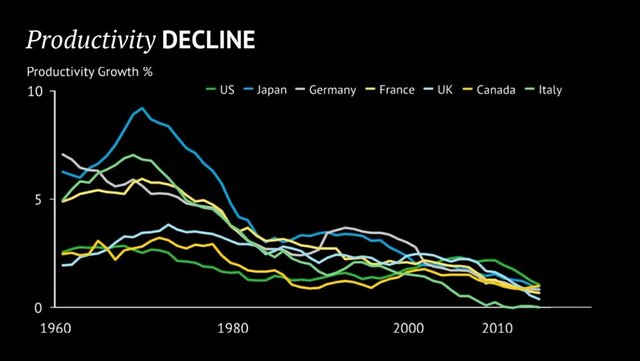
This is why we are not growing. We failed at reinventing the manufacturing space, and large technological innovations have played away from it. But what if we could combine those forces? What if the existing manufacturing and large technological innovation came together to create the next big manufacturing reinvention.
Bingo! This is the fourth manufacturing revolution, and it's happening right now. Major technologies are entering the manufacturing space, big time. They will boost industrial productivity by more than a third.This is massive, and it will do a lot in creating growth. Let me tell you about some of them.
Have you already met advanced manufacturing robots? They are the size of humans, they actually collaborate with them, and they can be programmed in order to perform complex, non-repetitive tasks.Today in our factories, only 8 percent of the tasks are automated. The less complex, the more repetitive ones. It will be 25 percent in 10 years. It means that by 2025, advanced robots will complement workers to be, together, 20 percent more productive, to manufacture 20 percent more outputs, to achieve 20 percent additional growth.

This isn't some fancy, futuristic idea. These robots are working for us right now. Last year in the US, they helped Amazon prepare and ship all the products required for Cyber Monday, the annual peak of online retail. Last year in the US, it was the biggest online shopping day of the year and of history. Consumers spent 3 billion dollars on electronics that day. That's real economic growth.
Then there's additive manufacturing, 3D printing. 3D printing has already improved plastic manufacturing and it's now making its way through metal. Those are not small industries. Plastic and metals represent 25 percent of global manufacturing production.
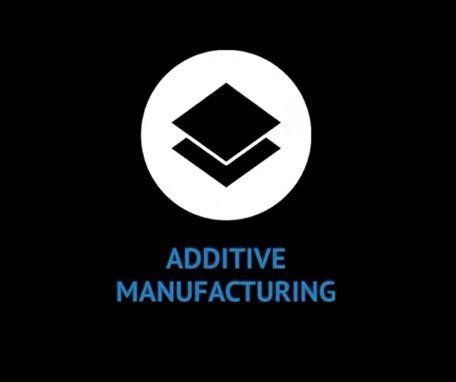
Let's take a real example. In the aerospace industry, fuel nozzles are some of the most complex parts to manufacture, for one reason: they are made up of 20 different parts that need to be separately produced and then painstakingly assembled. Aerospace companies are now using 3D printing, which allows them to turn those 20 different parts into just one. The results? 40 percent more productivity, 40 percent more output produced, 40 percent more growth for this specific industry.
But actually, the most exciting part of this new manufacturing revolution goes much beyond productivity.It's about producing better, smarter products. It's about scale customization. Imagine a world where you can buy the exact products you want with the functionalities you need, with the design you want, with the same cost and lead time as a product that's been mass produced, like your car, or your clothes or your cell phone. The new manufacturing revolution makes it possible.
Advanced robots can be programmed in order to perform any product configuration without any setup time or ramp up. 3D printers instantaneously produce any customized design. We are now able to produce a batch of one product, your product, at the same cost and lead time as a batch of many. Those are only a few examples of the manufacturing revolution at play.
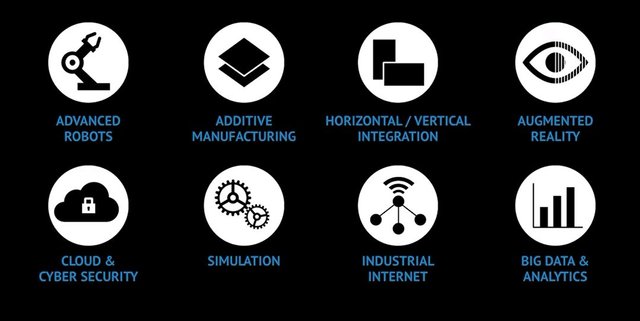
Not only will manufacturing become more productive, it will also become more flexible, and those were exactly the elements of growth that we are missing. But actually, there are even some bigger implications for all of us when manufacturing will find its way back into the limelight. It will create a huge macroeconomic shift.
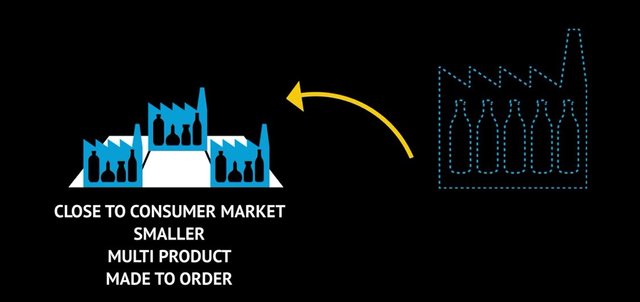
First, our factories will be relocated into our home markets. In the world of scale customization, consumer proximity is the new norm.
Then, our factories will be smaller, agile. Scale does not matter anymore, flexibility does. They will be operating on a multi-product, made-to-order basis. The change will be drastic.
Globalization will enter a new era. The East-to-West trade flows will be replaced by regional trade flows.East for East, West for West. When you think about that, the old model was pretty much insane. Piling up stocks, making products travel the whole world before they reach their end consumers. The new model, producing just next to the consumer market, will be much cleaner, much better for our environment. In mature economies, manufacturing will be back home, creating more employment, more productivity and more growth. Good news, isn't it?
But here's the thing with growth -- it does not come automatically. Mature economies will have to seize it.We'll have to massively re-train our workforce. In most countries, like in my country, France, we've told our children that manufacturing had no future. That it was something happening far away. We need to reverse that and teach manufacturing again at university. Only the countries that will boldly transform will be able to seize this growth.
It's also a chance for developing economies. Of course China and other emerging economies won't be the factory of the world anymore. Actually, it was not a sustainable model in the long term, as those countries are becoming richer. Last year, it was already as expensive to produce in Brazil as to produce in France. By 2018, manufacturing costs in China will be on par with the US.
The new manufacturing revolution will accelerate the transition of those emerging economies towards a model driven by domestic consumption. And this is good, because this is where growth will be created.In the next five years, the next billion consumers in China will inject more growth in our economies than the top five European markets together.
This fourth manufacturing revolution is a chance for all of us. If we play it right, we'll see sustainable growth in all of our economies. This means more wealth distributed to all of us and a better future for our children.
I like this article. Very good stuff. I am from No 1. country on the list. Automation is key driver of our economy. I can support this theory.
https://www.reddit.com/r/MapPorn/comments/3712w0/vehicles_produced_per_capita_by_country_in_2014/
Downvoting a post can decrease pending rewards and make it less visible. Common reasons:
Submit
thank you airmike..
Downvoting a post can decrease pending rewards and make it less visible. Common reasons:
Submit
welcome :)
Downvoting a post can decrease pending rewards and make it less visible. Common reasons:
Submit